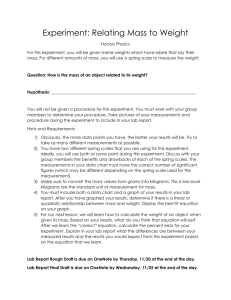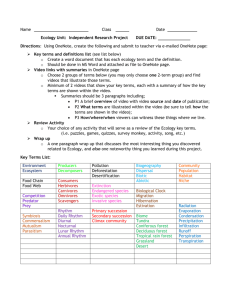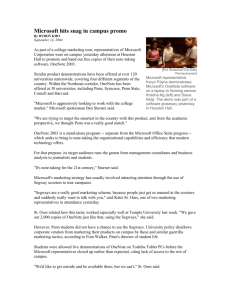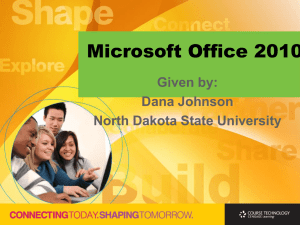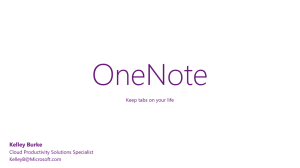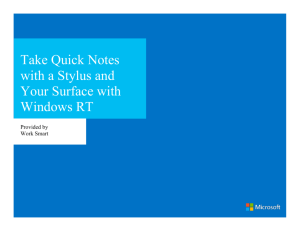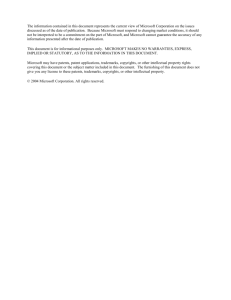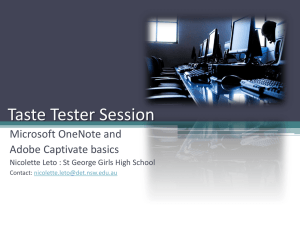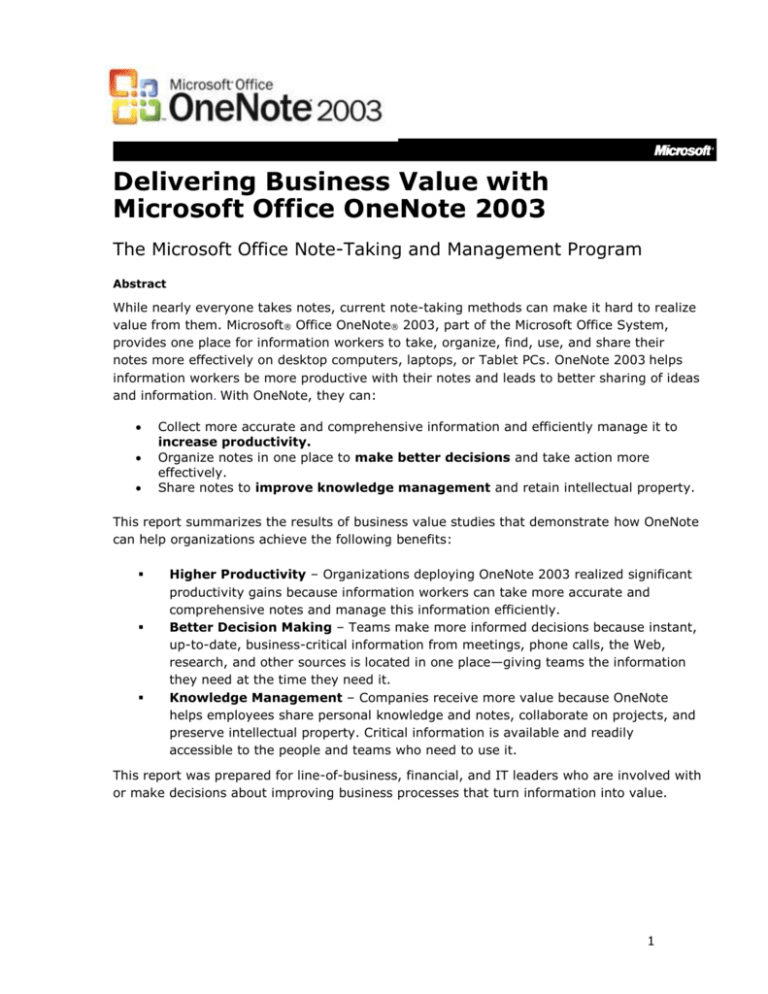
Delivering Business Value with
Microsoft Office OneNote 2003
The Microsoft Office Note-Taking and Management Program
Abstract
While nearly everyone takes notes, current note-taking methods can make it hard to realize
value from them. Microsoft® Office OneNote® 2003, part of the Microsoft Office System,
provides one place for information workers to take, organize, find, use, and share their
notes more effectively on desktop computers, laptops, or Tablet PCs. OneNote 2003 helps
information workers be more productive with their notes and leads to better sharing of ideas
and information. With OneNote, they can:
Collect more accurate and comprehensive information and efficiently manage it to
increase productivity.
Organize notes in one place to make better decisions and take action more
effectively.
Share notes to improve knowledge management and retain intellectual property.
This report summarizes the results of business value studies that demonstrate how OneNote
can help organizations achieve the following benefits:
Higher Productivity – Organizations deploying OneNote 2003 realized significant
productivity gains because information workers can take more accurate and
comprehensive notes and manage this information efficiently.
Better Decision Making – Teams make more informed decisions because instant,
up-to-date, business-critical information from meetings, phone calls, the Web,
research, and other sources is located in one place—giving teams the information
they need at the time they need it.
Knowledge Management – Companies receive more value because OneNote
helps employees share personal knowledge and notes, collaborate on projects, and
preserve intellectual property. Critical information is available and readily
accessible to the people and teams who need to use it.
This report was prepared for line-of-business, financial, and IT leaders who are involved with
or make decisions about improving business processes that turn information into value.
1
June 2004
The information contained in this document represents the current view of Microsoft Corporation on the issues discussed
as of the date of publication. Because Microsoft must respond to changing market conditions, it should not be interpreted
to be a commitment on the part of Microsoft, and Microsoft cannot guarantee the accuracy of any information presented
after the date of publication.
This document is for informational purposes only. MICROSOFT MAKES NO WARRANTIES, EXPRESS OR IMPLIED, AS
TO THE INFORMATION IN THIS DOCUMENT.
Complying with all applicable copyright laws is the responsibility of the user. Without limiting the rights under copyright, no
part of this document may be reproduced, stored in or introduced into a retrieval system, or transmitted in any form or by
any means (electronic, mechanical, photocopying, recording, or otherwise), or for any purpose, without the express
written permission of Microsoft Corporation.
Microsoft may have patents, patent applications, trademarks, copyrights, or other intellectual property rights covering
subject matter in this document. Except as expressly provided in any written license agreement from Microsoft, the
furnishing of this document does not give you any license to these patents, trademarks, copyrights, or other intellectual
property.
© 2004 Microsoft Corporation. All rights reserved.
Microsoft, bCentral, the OneNote logo, OneNote, Outlook, SharePoint, Windows, and Windows Server are either
registered trademarks or trademarks of Microsoft Corporation in the United States and/or other countries. The names of
actual companies and products mentioned herein may be the trademarks of their respective owners.
TABLE OF CONTENTS
INTRODUCTION
3
PRODUCTIVITY
4
4
4
5
LAWYERS MAKE THE CASE FOR ONENOTE 2003
CONSULTING FIRM USES ONENOTE TO BETTER MANAGE PROJECT INFORMATION
JOURNALISTS BREAK NEWS FASTER WITH ONENOTE 2003
BETTER DECISION MAKING
PRODUCT DEVELOPMENT FIRM EXPERIENCES FASTER CLOSE RATES
ARCHITECTS COMPLETE DESIGN PROJECTS MORE EXPEDITIOUSLY
CONSTRUCTION FIRM FINDS A COST-SAVING DECISION-MAKING PROCESS
KNOWLEDGE MANAGEMENT
TELESALES GROUP ACCELERATES THE SALES PROCESS WITH ONENOTE 2003
MARKETING FIRM REDUCES COSTS WITH IMPROVED KNOWLEDGE RETENTION
GLOBAL CONSULTANTS IMPROVE TEAMWORK AND KNOWLEDGE TRANSFER
CONCLUSION
HOW BENEFITS WERE MEASURED
FOR MORE INFORMATION
6
6
7
8
9
9
10
12
13
13
13
2
Introduction
Organizations that purchase and deploy Microsoft® Office OneNote® 2003 can achieve cost
reductions and other quantifiable business benefits by generating work process
improvements in the areas of productivity, decision making, and knowledge management.
OneNote 2003 can substantially enhance the ability of individuals and teams to share
information, collaborate successfully, and respond quickly to changes in the workplace and
marketplace.
OneNote 2003 offers information workers a more effective and flexible way to take, organize,
and share their notes. Through its innovative design, OneNote fosters communication and
collaboration among teams or organizations. From law firms and media newsrooms to
consulting firms and construction companies, organizations are finding exciting ways to apply
OneNote in business scenarios to drive better bottom-line value.
Nine such organizations are highlighted in this report. Standard financial measures were
calculated for their OneNote investments, and were used to assess the total value of their
OneNote solutions. The return-on-investment measures include net present value per user,
internal rate of return, and payback period. The findings are based on the Business Value
Analysis practice of Hollen, Inc., an independent consulting firm.
Key findings of the business value studies conducted at the nine organizations identified:
Rapid Payback – The median payback period on investments in Microsoft Office
OneNote 2003 is five months. For 63 percent of companies studied, they plan to
recover their investments in the solution in less than six months.
Significant Value per User – All nine organizations in this study realized direct
business benefits from deploying OneNote 2003. The median net present value
expected is U.S.$2,561 per user.
Meaningful Rate of Return – The internal rate of return for OneNote investments
is estimated to be 256 percent. Even the low value of 194 percent far exceeds the
hurdle rate at any company.
Microsoft Office OneNote 2003 Demonstrates Significant Business Value
Business value studies at nine organizations demonstrate that OneNote 2003
consistently provides a positive return on investment.
Traditional Measures
Median
Mean
Range
Internal Rate of
Return
234%
256%
194% to
362%
Payback Period
5 months
4.88 months
3 to 6 months
$2,561
$2,454
$1,462 to
$3,646
Net Present Value
per User
3
Productivity
Personal and team productivity is vital to being competitive in today’s marketplace.
Microsoft realized that a program like OneNote 2003 could help individuals and
organizations change the way they work, allowing them to dispense with routine and
burdensome tasks while enhancing organizational productivity and business value.
“When we can get a job done more quickly, we save time and our client saves
money. OneNote helps us be more efficient, a quality that is important to us and
our clients.”
— Peter Sullivan, Partner, Litigation Group, Hughes Hubbard & Reed
Productivity: Lawyers Make the Case for OneNote 2003
At Hughes Hubbard & Reed’s legal offices around the world, lawyers use Microsoft Office
OneNote 2003 to gather, organize, search, and share information; brainstorm legal
arguments; prepare cases; and record witness testimony. Instead of jotting down notes on
paper during phone calls and meetings, lawyers quickly type in OneNote files on their
laptops and desktops, or they write in OneNote on their Tablet PCs.
Prior to going to court, lawyers take depositions—recorded testimony under oath—from
witnesses and experts. Before OneNote, attorneys would lug a bulky tape recorder and
boxes of case files to deposition hearings, and then secretaries or paralegals would spend
time transcribing the testimony. Now lawyers take depositions on their laptops or Tablet PCs
by using the recording features of OneNote. As a result, note taking is accurate and
comprehensive, and time-consuming transcription is unnecessary.
“The audio recording is synchronized to our questions and the witnesses’ answers,” says
Ron Abramson, a partner in the firm. “You can play back the exact words from the
testimony given under oath and share the testimony with anyone who needs it.”
After two months of using OneNote, employees at Hughes Hubbard & Reed found that the
amount of time spent taking, sorting, and rearranging notes decreased by 54 percent.
Partners anticipate the timesaving features of OneNote will lead to nearly $2,500 in annual
benefits per user, and, ultimately, to improved client satisfaction and increased business.
Productivity: Consulting Firm Uses OneNote 2003 to Better
Manage Project Information
Increased individual and team productivity also is achieved with Microsoft Office OneNote
2003 at Infosys Technologies, an information technology and consulting firm based in India.
One of its key divisions, the Microsoft Solutions Practice (MSSP), supports the company’s
business units by providing technology solutions to its clients.
Accurate and timely information from client interviews, research, and brainstorming
sessions is vital to MSSP’s work. With OneNote, Infosys MSSP consultants can easily find
4
and use current information in their notes and research, which helps them complete client
projects almost 7 percent faster and ultimately benefits the Infosys bottom line.
Sharing of notes increased by 11 percent, which means greater collaboration with team
members, the business units, and clients. “Productivity is higher because OneNote makes
managing notes from client interviews and research easy for consultants,” says Ravi Kant,
Technical Architect, Microsoft Solutions Practice at Infosys Technologies. “Finding
information from hundreds and thousands of notes takes seconds with the search
functionality.”
MSSP consultants at Infosys have more time to devote to developing technology solutions
and other billable client work because OneNote provides a better, faster way to perform
ordinary yet essential tasks. The risk of errors or lost information is minimized because
everyone accesses data from the central server. “The time saved is significant because we
find information more quickly and easily with OneNote,” says Kant. “And we are confident
that we won’t lose any information.”
Infosys will realize a net present value—the total value from investing in this solution—of
$1,903 per user over three years, and the company expects to recoup its investment in
OneNote within five months.
Productivity: Journalists Break News Faster with OneNote 2003
Similar productivity gains are being experienced at Globo Online, a division of the Globo
Organization, the largest media company in Brazil. Using OneNote, Globo Online is beating
its competition at breaking stories and estimates annual productivity gains of $65,910 for its
core team of 50 journalists. To find out more about how Globo Online uses OneNote, to view
a video case study taped at Rio’s Carnaval, or to search for other OneNote case studies:
www.microsoft.com/office/onenote/business/
OneNote 2003 Improves Personal and Team Productivity
Several companies have used Microsoft Office OneNote 2003 to enhance productivity and help establish a
competitive advantage.
Company
Process
Business Metric
Hughes,
Hubbard &
Reed
Centralized case files
• Complete short projects 27% faster
• Get up to speed on new cases 18% faster
• Improve document turnaround time by 15%
Infosys
Team reuse of
research & proposals
• Complete client projects 7% faster
• Save $1,903 per user annually by increased productivity
Globo Online
Timely communication
of rich media
• Save $65,910 annually by increased productivity
• Beat the competition by breaking news over 50% faster
5
Better Decision Making
When Microsoft Office OneNote 2003 is deployed in combination with Microsoft Office
Outlook® 2003 and Windows® SharePoint® Services, information workers can update their
notes and make the new data instantly available to all team members. Managers who have
to make critical decisions can do so with the assurance that they have the most current
information.
“Of three new projects that we landed, two were directly related to our ability to
communicate with each other using OneNote.”
— Scott Bright, Vice President of Operations, Synapse
Better Decision Making: Product Development Firm Experiences
Faster Close Rates
Having detailed information instantly available can make or break a deal, particularly for a
product development company like Synapse, where the innovative team of engineers helps
bring new inventions, such as an anthrax detector, to market. To provide customers with
up-to-date and often complex information, specialty engineers must share their unique
technical expertise with other team members.
Using Microsoft Office OneNote 2003, engineers can easily collect, organize, share, and
retain ideas and project information. By using OneNote’s search functionality, they no
longer have to spend time looking through copious notes for that critical piece of
information. Teams have the ability to access the information they need and the advantage
of having instant, up-to-date information that allows them to make more informed
decisions.
OneNote also provides real-time business development support to engineers. For instance,
an engineer at a high-level client meeting sends an instant message to a remote team
member, asking for input on a specific question. The colleague quickly researches
information and then sends notes, copies of Web pages, sketches, and other necessary
information all in a single OneNote document by e-mail. The on-site Synapse representative
becomes an immediate expert, answering complex questions with authority.
“Of three new projects that we landed, two were directly related to our ability to
communicate with each other using OneNote,” says Scott Bright, Vice President of
Operations at Synapse. “For example, at a recent prospective client meeting, we had
immediate access to notes, drawings, and possible scenarios—all documented in OneNote.
Meetings like that go much more smoothly with such preparatory information at our
fingertips.”
6
Better Decision Making: Architects Complete Design Projects
More Expeditiously
A Seattle-based architecture firm, Johnson Braund Design Group (JBDG), and its partner,
Cole + Russell Architects in Cincinnati, make critical decisions with the assurance that they
have the latest information available in Microsoft Office OneNote 2003. The two companies
work together on hotel projects for Marriott International by using OneNote 2003 files
located on a secure, shared Web site hosted by the Microsoft bCentral TM portal using
Windows SharePoint Services.
Because the two firms are nearly 2,000 miles apart, success depends on clear, visually rich,
accurate, and timely information to communicate with internal teams, partners, clients,
general contractors, zoning boards, and other regulatory agencies. OneNote enhances the
ability of architects and other team members to share project information in any location.
Architects at both firms can access up-to-date information—such as code requirements,
building material, and project status—which helps them make better decisions at each step
of every hotel project.
The architects no longer have to rely on distorted black-and-white faxes to send requests
and exchange information, so communications with other architects and contractors at job
sites are much clearer—and less prone to errors and misunderstandings. As a result, the
ability to meet deadlines has improved.
Figure 1. Architects clearly communicate design changes by marking up digital photos imported into
OneNote. Their jotted notes draw attention to key information on which to base decisions.
Because the architects share design concepts, zoning requirements, and client information—
accurately and nearly in real time—a project can be completed faster and lead to increased
revenue. Joe Mattoni, Project Manager at JBDG, expects the benefits of OneNote used with
7
a bCentral site to help the firms manage and finish the hotel projects every other week
instead of once a month.
“OneNote gives us better collaboration, an improved ability to meet deadlines, and clarity in
communications, which ultimately helps us better serve our clients,” says Mattoni. “All of
our architects are excited about this major win. We anticipate that OneNote will help us
complete 26 construction projects a year with greater consistency—that’s a huge benefit.”
Better Decision Making: Construction Firm Finds a Cost-Saving
Decision-Making Process
The Nassal Company—a leading specialty contractor for entertainment-related projects such
as the Men in BlackTM Alien AttackTM ride at Universal Studios Florida—also benefits from
better decision making because of improved collaboration with remote teams of owners,
developers, designers, and architects.
“With OneNote, information is shared quickly so we get an instant response,” says Stephen
Dodson, Project Manager, The Nassal Company. “Production can continue at a steady rate,
resulting in savings in the ballpark of tens of thousands of dollars on some projects.”
Find out about other benefits that The Nassal Company is receiving from OneNote, view a
video case study taped at SeaWorld, or search for other OneNote case studies:
www.microsoft.com/office/onenote/business/
OneNote Improves Organizational Decision Making
Several companies have used Microsoft Office OneNote 2003 to make critical decisions with the assurance that
they have the most current information.
Company
Process
Business Metric
The Nassal
Company
Dispersed decisionmakers
• Decreases time lag between approvals 37%
• Facilitates communication with remote workers
• Increases note sharing to 25.9% from 3.4%
Synapse
Collaboration with
experts to deliver on
customer expectations
• Increases sales close rates by 50%
• Increases cross-team communication and collaboration
• Decreases search time for information by 30%
Johnson
Braund
Shared research with
customers, partners,
and colleagues
• Clearer, more accurate communication
• Improved team work with easier access to project
information shared in near real time
8
Knowledge Management
Microsoft Office OneNote 2003 promotes and facilitates effective team collaboration, making
it an important asset for any organization. With OneNote, teams can share information in
such a way that all members, no matter where they are located, have the same view of the
notes and the same up-to-date information.
“With OneNote, our team can share information about customer intelligence more
quickly and efficiently, which means a sales opportunity can be moved along with
more speed.”
— Jay Womeldorf, Vendor Telesales Manager, VMC Consulting Corporation
Knowledge Management: Telesales Group Accelerates the Sales
Process with OneNote
Collecting and sharing customer information are at the heart of a successful telesales
business such as VMC Consulting Corporation. Using Microsoft Office OneNote 2003 with
Siebel CRM on their desktop computers, the VMC sales team can take, organize, and share
notes more effectively than they can by using CRM alone. According to a usage and financial
survey, sales representatives shared their notes with coworkers about 5 percent of the time
before OneNote 2003 was deployed. This number rose to 18.5 percent after consultants
deployed OneNote.
Using Microsoft Windows SharePoint Services in the Microsoft Windows ServerTM 2003
operating system, sales representatives also put their notes from Web research, customer
inquiries, background information, audio files, and solution diagrams in one place that is
searchable by all members. With shared OneNote sections on SharePoint sites, all team
members can view the same versions of notes. When the notes are updated, all team
members will have the updates instantly.
When a customer calls a VMC sales representative to inquire about a specific product or
solution, the sales representative can search with instant results. (See Figure 2.) This
reduces the amount of time the sales representative spends searching, eliminates the time
consumed by contacting the customer again, and, most important, can significantly enhance
customer satisfaction.
9
As a result of the time-saving OneNote features, VMC expects to save nearly $2,000
annually per user. “With OneNote, our team can share information about customer
intelligence more quickly and efficiently, which means a sales opportunity can be
moved along with more speed,” says Jay Womeldorf, Vendor Telesales Manager,
VMC Consulting Corporation.
Figure 2. VMC sales representatives used this OneNote-based document to collect and search typed and
handwritten notes, images, audio files, and additional information from a variety of sources.
OneNote also is used as a knowledge repository, so sales representatives can quickly access
company training content, processes and procedures, and product information. If a VMC
sales representative moves off the team, customer information remains with the company
in easy-to-find OneNote-based documents on the SharePoint site, instead of in a box where
it may be thrown away later.
New hires at VMC can easily access human resources documents, office procedures, training
modules, links to video demonstrations, product information, and customer intelligence from
OneNote files stored on the SharePoint site. This decreases by 25 percent the time required
for a new employee to become fully productive.
Knowledge Management: Marketing Firm Reduces Costs with
Improved Knowledge Retention
Collecting and sharing information is an everyday occurrence at Cheskin, a successful
marketing consulting firm based in Redwood Shores, California, and with offices in three
additional U.S. markets and Mexico City. Cheskin gathers a massive volume of information
10
about clients, ideas, designs, and projects, forming an invaluable knowledge base that
employees need to access regularly. For example, proposals created for one customer can
form the basis for new bids because ideas that do not work for one client may be ideal for
another. These types of proposals can often take weeks to create, so reusing them is
invaluable.
Cheskin’s Chief Executive Officer, Christopher Ireland, deployed Microsoft Office OneNote
2003 to streamline processes and increase efficiency within her firm. With OneNote,
marketing consultants can easily collect, organize, find, share, and retain ideas and
information from a project’s proposal stage to its completion. They use OneNote to track
leads, create proposals, manage projects, draft reports, and collect client information using
customized templates.
Figure 3. Cheskin marketing consultants created custom stationery in OneNote to collect, and then reuse,
the right information in the right format for each new client.
Retaining and transferring knowledge is also of utmost importance to Cheskin because
training costs for a new employee reach almost $10,000. When a consultant changes teams
or when a new employee is hired, the first task is to review background information
collected in OneNote files. As more employees are hired, Cheskin expects a 30 percent
decrease in the time it takes to get a new employee up to speed.
As with any professional services firm that generates the majority of its revenue from client
billings, productivity directly correlates to the bottom line. With the improved knowledge
11
transfer capabilities provided by OneNote, Cheskin’s revenue-generating employees are
accelerating the value they bring to the firm.
Knowledge Management: Global Consultants Improve Teamwork
and Knowledge Transfer with OneNote 2003
With 106,000 employees and offices in more than 140 countries, a massive amount of
information circulates throughout the consultancy firm of Ernst & Young (EY). Since the EY
Brazil office deployed OneNote, employee sharing of important notes about customers and
projects is up 34 percent. EY Brazil projects more than a 20 percent increase in its ability to
retain and reuse company knowledge and research from previous client projects, leading to
faster delivery of results. Find out how EY Brazil teams are communicating better and
achieving business objectives with speed and agility:
www.microsoft.com/office/onenote/business/
OneNote 2003 Improves Organizational Knowledge Management
Several companies have used Microsoft Office OneNote 2003 to promote and facilitate effective team
collaboration and knowledge management.
Company
Process
Ernst &
Young, Brazil
Shared meeting
notes
• Enhances the ability to retain and reuse knowledge by 20%
• Increases sharing of important notes about projects by 34%
Business Metric
Cheskin
Reusable
knowledge base
• Time savings of 30% to get new employees up to speed
• Increased confidence with efficient, streamlined processes
VMC
Consulting
Training
database
• Decreases search time for information by 50%
• Facilitates better communication with the field sales force
12
Conclusion
With Microsoft Office OneNote 2003, not only can information workers change how they
take notes, but they also can manage, store, prioritize, and act on those notes in ways that
can change how business is conducted.
OneNote provides a single location in which information workers can preserve their
handwritten, typed, and recorded notes and research. Since this location is searchable and
sharable, companies can depend on that information, knowing that they have current,
reliable, retrievable information to which they can refer at will—minimizing the risk of
misinterpretations and inaccurate notes that can lead to missed opportunities. Companies
that take advantage of this capability enhance their opportunities for success with clients
and team members.
In combination with other Microsoft Office System programs, OneNote can transform
internal business processes so information workers can be more productive in meetings, at
their desks, at presentations, and in brainstorming sessions—anywhere they work with
ideas and notes. More importantly, OneNote will substantially enhance the ability of
individuals and teams to share information, collaborate successfully, improve decision
making, and respond quickly to changes in the workplace and marketplace.
For More Information
For information about the business value of OneNote 2003 and other customer case studies,
see www.microsoft.com/office/onenote/business/
How Benefits Were Measured
These findings are based on Hollen, Inc.’s Business Value Analysis practice. Hollen, an independent consulting organization,
conducted client surveys, analyzed all business value contributions to nine companies, and conducted a cost-benefit analysis using
proven financial metrics and tools associated with the investment in the OneNote solution. Microsoft retained Hollen to review the
economic justification of OneNote solutions with select customers and to validate the linkage between investments in OneNote and
quantifiable business benefits to these customers. Costs associated with software, testing, and training were included in the studies.
13

